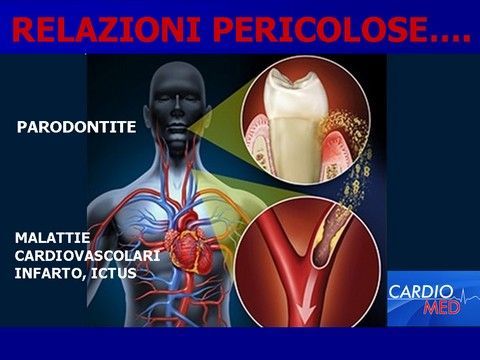
CORRELAZIONE TRA PARODONTITE E FIBRILLAZIONE ATRIALE
La scoperta emerge da uno studio condotto da un team di ricercatori della Hiroshima University, in Giappone
La parodontite è una malattia dentale ad eziologia batterica e a patogenesi infiammatoria. Nota anche come piorrea, è una patologia piuttosto subdola che, se non curata, porta alla diminuzione dei tessuti che assicurano sostegno e stabilità ai denti. Spesso, il primo sintomo che allarma il paziente consiste nell’aumento della mobilità dentale, che, in assenza di trattamenti adeguati, progredisce lentamente fino alla caduta degli stessi. Una recente ricerca giapponese ha scoperto una significativa correlazione tra questa patologia e la fibrillazione atriale. In particolare è un team di esperti della Hiroshima University ad aver fatto luce su questo collegamento apparentemente impensabile. I risultati dello studio sono stati pubblicati sulla prestigiosa rivista ‘JACC Journals’.
Ma entriamo nel dettaglio. Il lavoro giapponese ha coinvolto 76 pazienti con malattia cardiaca. Il gruppo di lavoro ha rimosso chirurgicamente le appendici atriali sinistre dei pazienti per poi analizzare il tessuto e stabilire la correlazione tra la gravità della fibrosi atriale e quella della malattia gengivale. “Le parodontiti sono associate con infiammazioni a lungo termine e l’infiammazione ha un ruolo chiave nella progressione della fibrillazione atriale e nella patogenesi di questa condizione” – ha spiegato Shunsuke Miyauchi, coordinatore della ricerca.
Da quanto evidenziato dalla ricerca, soprattutto, più grave e la parodontite peggiore è la fibrosi. Un aspetto che suggerisce come l’infiammazione delle gengive possa intensificare sia l’infiammazione sia la malattia cardiaca. Secondo il team, dunque, oltre a migliorare i fattori di rischio modificabili come peso, attività fisica, uso di tabacco e alcool, diventa opportuno curare le parodontiti. Ma soprattutto, come dichiarato dagli autori, “è fondamentale coinvolgere i dentisti nella gestione della fibrillazione atriale”.
Relationship Between Periodontitis and Atrial Fibrosis in Atrial Fibrillation: Histological Evaluation of Left Atrial Appendages
Atrial Fibrillation - Mechanisms
Shunsuke Miyauchi, Hiromi Nishi, Kazuhisa Ouhara, Takehito Tokuyama, Yousaku Okubo, Sho Okamura, Shogo Miyamoto, Naoto Oguri, Yukimi Uotani, Taiichi Takasaki, Keijiro Katayama, Hisako Furusho, Mutsumi Miyauchi,
Abstract
Background
Atrial fibrosis contributes to the onset and persistence of atrial fibrillation (AF) and AF-related stroke. Periodontitis, a common infectious and inflammatory disease, aggravates some systemic diseases. However, the association of periodontitis with AF and with atrial fibrosis has remained unclarified.
Objectives
The authors aimed to elucidate the relationship between periodontitis and atrial fibrosis by studying resected left atrial appendages (LAAs).
Methods
Seventy-six patients with AF (55 with nonparoxysmal AF, 25 with mitral valve regurgitation, 18 with LAA thrombus) who were scheduled to undergo LAA excision during cardiac surgery were prospectively enrolled. All patients underwent an oral examination, and the remaining number of teeth, bleeding on probing, periodontal probing depth, and periodontal inflamed surface area (PISA) were evaluated as parameters of periodontitis. The degree of fibrosis in each LAA was quantified by Azan–Mallory staining.
Results
Bleeding on probing (R = 0.48; P < 0.0001), periodontal probing depth of ≥4 mm (R = 0.26; P = 0.02), and PISA (R = 0.46; P < 0.0001) were positively correlated with atrial fibrosis. Among patients with >10 remaining teeth, PISA was positively and strongly correlated with atrial fibrosis (R = 0.57; P < 0.0001). After adjustments for age, AF duration, BMI, mitral valve regurgitation, and CHADS₂ (congestive heart failure, hypertension, age, diabetes, previous stroke/transient ischemic attack) score, PISA was significantly associated with atrial fibrosis (β = 0.016; P = 0.0002).
Conclusions
The authors histologically revealed the association of periodontitis with atrial fibrosis. This indicates that periodontitis, which is modifiable, is likely a risk factor for AF.
SEDE
Corso Vittorio Emanuele, 143
84123 Salerno
ORARI DI APERTURA
- Lun - Ven
- - -
- Sab - Dom
- Chiuso




